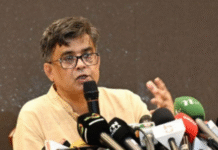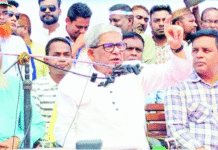The Daily Star

As the Delta variant continues to spread and the number of critical coronavirus patients keeps rising in hospitals, the country faces the bleak prospect of running out of Covid-dedicated beds, especially those in ICUs.
Major hospitals have already become overburdened due to the rush of Covid patients, with around 81.65 percent out of 1,471 ICU beds, designated for treating the disease countrywide, remaining occupied as of yesterday noon.
The ICU occupancy rate has doubled in one month since June 14, according to the Covid-19 Dynamic Dashboard of the DGHS.

In the Covid-dedicated facilities, 71 percent of general beds, 82 percent of all beds in the high dependency unit (HDU), and 65 percent of all beds with high-flow nasal cannulas (HFNC) have been occupied in the meantime.
A month ago, the ICU occupancy rate was 37 percent, general beds 33 percent, HDU 24 percent and HFNC beds 37 percent, according to the dashboard data.
Health officials said ICU beds are filling up thick and fast as around 50 percent of the Covid patients are coming to the hospital in critical condition.
With new daily cases reported over 11,000 in the last week and the positivity rate around 30 percent, experts fear healthcare facilities across the country including those in Dhaka may face a bigger crisis than it experienced in April this year if runaway infections are not reined in.
They say transmission has not come down as expected during the ongoing lockdown that started from the first day of July.
The Delta variant, far more transmissible than all other strains, has brought the healthcare system in India to its knees. And since its first detection in Bangladesh on May 8, this variant caused health disasters across Khulna and Rajshahi regions before reaching other parts of the country.
On Saturday, there were at least 11 patients — five of them from outside Dhaka — waiting to be admitted at the DNCC Covid-19 Dedicated Hospital in the capital between 3:15pm and 4:10pm.
Mongla Bishwas, 45, was one of them, having been brought to the country’s biggest Covid facility with his oxygen saturation level at 75 percent. The on-duty nurse at the triage area said the patient needed high-flow oxygen therapy.
“However, not a single bed with high-flow nasal cannula was vacant. We will admit the patient anyway,” the nurse said, preferring not to be named.
There were around 70 ICU beds officially vacant at the hospital at that time. Multiple staffers, however, said those ICU beds had no high-flow nasal cannula (HFNC), meaning no critical patient needing high-flow oxygen therapy can be treated in these ICU beds.
For the past week, the DNCC hospital has been receiving around 80 patients daily on an average, according to the officials.
As of yesterday noon, the hospital was treating 501 Covid patients, 481 of them in critical condition.
The patients were occupying 167 out of 212 ICU beds, all of the 288 HDU beds, and all of the 12 beds with HFNC. Only 40 patients were receiving treatment in general beds, numbering 500 at the hospital.
“Around 40 percent are coming at a critical point of their illnesses. But we cannot provide high-flow oxygen therapy at once to all of them as all HFNC beds have been remaining occupied for more than a week,” an on-duty doctor at the hospital told The Daily Star seeking anonymity.
Due to several official embargos, including Thursday’s one, imposed by the Dhaka Civil Surgeon office, none of the public healthcare staff are interested in being quoted in the media.
Contacted, Brig Gen AKM Nasir Uddin, director of the hospital, told this newspaper that the rush for patients has increased in the past week.
“We still have vacant ICU beds as well as general beds. But our capacity will be exceeded soon if such a rush continues,” Brig Gen AKM Nasir Uddin said.
While the DNCC hospital had many general beds vacant, Dhaka Medical College Hospital was close to surpassing its capacity as 92 percent of its 827 general beds were occupied on Sunday, according to the Covid dashboard data updated till July 11.
All the 20 ICU beds for Covid in Dhaka Medical College Hospital (DMCH) were occupied yesterday, according to the DGHS press release, while 55 out of 65 HFNC beds and 29 out of 37 HDU beds were engaged till Sunday.
DMCH Director Brigadier General Nazmul Haque told this newspaper on Sunday, “The rush of Covid patients has increased recently. But we are still capable of treating them with the resources we have.”
Except for the DNCC hospital, there are 15 other public hospitals treating Covid patients in Dhaka city where the ICU bed occupancy rate was around 86 percent against a total 183 beds yesterday.
Besides, all 300 beds in Kurmitola General Hospital have been occupied for more than a week while the bed occupancy rate was 91 percent of 195 beds in Kuwait-Bangladesh Friendship Hospital, and 78 percent of 384 beds in Mugda General Hospital.
While official data shows more than 18 percent of ICU beds were vacant across the country, the reality, however, indicates a number of those are not fully equipped to treat critical patients or have remained dysfunctional, according to healthcare professionals treating Covid patients.
For instance, two out of total 10 ICU beds have remained dysfunctional for the last two weeks in the Covid unit of Rangpur Medical College Hospital while four out of 20 ICU beds in Sylhet’s Shahid Shamsuddin Ahmed Hospital remained dysfunctional for several days, reports our district correspondents concerned.
The surge in patients has also put the oxygen supply chain under immense pressure as the daily demand has increased to 220 tonnes from 100 tonnes of the normal time, according to Dr Farid Hossain Miah, director of hospitals and clinics at the DGHS.
“As the number of patients is increasing, the demand for oxygen is also rising by three percent daily. We are trying our best to tackle the situation with what we have,” Dr Farid told The Daily Star yesterday.
Due to the delay in filling up central oxygen tanks in at least three hospitals of Satkhira, Faridpur and Dhaka, some 11 patients died in the past two weeks, reports our correspondents.
DIVISIONAL STATUS
The overall bed occupancy rate in Covid hospitals has more than doubled in all divisions in the past one month from June 14, according to the dashboard data of the Management Information System (MIS) unit of the health directorate.
In over one month till yesterday, Mymensingh division recorded the highest increase in overall bed occupancy rate — from 22 percent to 111 percent — followed by Rajshahi — from 71 percent to 89 percent.
Meanwhile, Dhaka division saw a rise from 26 to 74 percent, Barishal from 26 to 67 percent, Khulna from 55 to 85 percent, Chattogram from 37 to 68 percent, Rangpur from 41 to 49 percent, and Sylhet from 28 to 65 percent.
The overall bed occupancy curve has been showing an upward trend in the past several days in Sylhet, Rajshahi, Khulna, and Dhaka divisions while in other divisions, it is very high despite a bit of a downward trend.
The curves for ICU, HDU and HFNC beds, however, have been showing an upward trend in all divisions meanwhile.
As of yesterday noon, at least 16 Covid-dedicated hospitals were treating extra patients against their capacity, according to DGHS data.
WHAT EXPERTS SAY
Experts said this trend may continue till the end of this month.
Prof Ridwanur Rahman, an infectious disease specialist, told this newspaper Tuesday, “The situation is grimmer than what it was in April. If there was easy transportation, the remaining high care hospital beds would have been occupied already. As the lockdown has been eased ahead of the Eid, the situation will deteriorate further.”
He suggested imposing curfew-like restrictions as the hospital bed occupancy has surpassed 70 percent. “Otherwise, the health care system will break down soon.”
Dr Mushtuq Hussain, consultant of the Institute of Epidemiology, Disease Control and Research (IEDCR), told The Daily Star on Sunday, “Despite the ongoing lockdown, the transmission has not decreased yet. So the pressure on the hospitals will also increase.”
He feared that the transmission will intensify in the cities when people will travel to their home districts for Eid-ul-Azha, which will be celebrated on July 21.
While the government has announced there will be five Covid field hospitals in Dhaka city, Dr Mushtuq urged the government to set up community-level hospitals by engaging the communities. “It will reduce the pressure on the hospitals,” he added.


 For all latest news, follow The Daily Star’s Google News channel.
For all latest news, follow The Daily Star’s Google News channel. 







